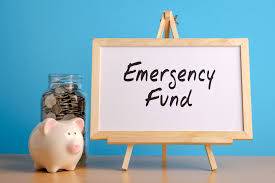Creating an emergency fund is a crucial step in financial planning. This fund acts as a safety net, providing financial stability during unexpected situations such as medical emergencies, job loss, or unforeseen expenses. Here's a comprehensive guide on how to build and maintain an emergency fund:
**1. Define Your Goal:**
- Assess your monthly living expenses, including rent or mortgage, utilities, groceries, and insurance.
- Aim to save at least three to six months' worth of living expenses. Adjust this goal based on your personal circumstances.
**2. Track Your Expenses:**
- Monitor your spending habits to identify areas where you can cut back and allocate funds to your emergency fund.
**3. Establish a Budget:**
- Create a realistic budget that prioritizes essential expenses. Allocate a portion of your income to saving for emergencies.
**4. Start Small:**
- If you can't save a significant amount initially, start with a smaller goal and gradually increase your contributions as your financial situation improves.
**5. Choose the Right Account:**
- Select a separate savings account for your emergency fund to prevent easy access and temptation. Consider high-yield savings accounts for better interest rates.
**6. Automate Savings:**
- Set up automatic transfers to your emergency fund each month. This ensures consistent contributions and reduces the temptation to spend the money elsewhere.
**7. Emergency Fund vs. Savings:**
- Distinguish between your emergency fund and regular savings. The emergency fund is for unexpected expenses, while savings can be for specific goals like vacations or large purchases.
**8. Prioritize Debt Repayment:**
- Tackle high-interest debt first to free up more money for your emergency fund. Once debt is reduced, redirect those funds toward savings.
**9. Reevaluate and Adjust:**
- Periodically reassess your living expenses and financial goals. Adjust your emergency fund target if there are significant changes in your life, such as a new job or increased living costs.
**10. Side Hustles and Additional Income:**
- Explore opportunities for additional income, such as freelance work or a part-time job. Use the extra earnings to boost your emergency fund.
**11. Financial Windfalls:**
- Allocate unexpected financial windfalls, like tax refunds or bonuses, to your emergency fund to expedite its growth.
**12. Resist Temptation:**
- Avoid dipping into your emergency fund for non-emergencies. Maintain discipline and understand the true purpose of the fund.
**13. Regularly Review and Reassess:**
- Periodically review your emergency fund strategy. Adjust the amount saved based on changes in your life circumstances, expenses, or income.
**14. Financial Education:**
- Continuously educate yourself about financial management. Understanding personal finance principles will empower you to make informed decisions about your emergency fund and overall financial health.
**15. Celebrate Milestones:**
- Acknowledge and celebrate milestones in your emergency fund journey. Recognizing your progress can motivate you to continue building a robust financial safety net.
By following these steps, you can establish and maintain a robust emergency fund, providing peace of mind and financial security in times of unforeseen challenges.


